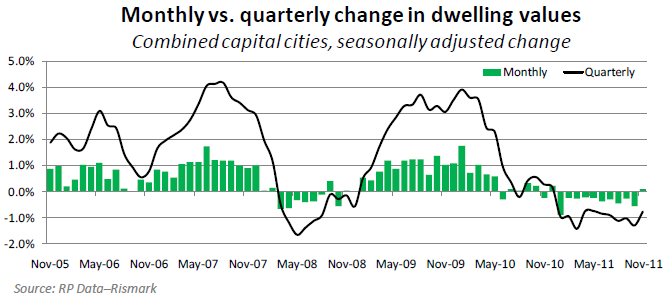Fairfax’s Chris Vedelago has published a marvellous piece of journalism at Domain today:
Counting eggs before they hatch
It’s amazing how little it takes to get some people in propertyland very excited.
Not long after RP Data-Rismark released its November property price data the industry was buzzing with “news” that the much-anticipated recovery for the residential real estate sector had finally started.
The headline alone was apparently enough to cause some to declare that happy days were here again (for agents and vendors, at least).
That the actual RP Data-Rismark numbers, and the commentary that followed from the two groups, was a lot more nuanced did not really matter.
Ah, nuance! The scourge of financial reporting! Chris continues:
Words like “spurs”, “boost”, and “rebound” got used a lot in the coverage. There was even talk of how the rate cut “worked its magic” and had a “real impact on immediate market recovery”.
So what remarkable movement in prices caused all this gushing?
A 0.1 per cent rise in dwelling values in a single month. That’s it.
Forget for a moment that in the past when prices have fallen by a fraction of 1 per cent such a movement was characterised as “flat” at best, “sideways” more commonly, or a “modest” or “minor” fall at worst.
Indeed, both bears and bulls are guilty of hyperbole and plucking monthly values and then annualising them to prove a point (which is materially different to analysing a trend of datapoints). Moreover, placing data in context is also usually lost as seen by the chart below:

One of the more coherent explanations of the context of the rise was Stephen Koukalas’ example:
If house prices keep rising at the same pace as they did in November (i.e., 0.1% per month), it will take around 3 and a half years to regain the nominal losses of the first 10 months of 2011! In real terms, even with 3 and half years of 0.1% monthly rises, house prices will be down a further 10% or so over that time.
Chris Vedelago continues with the supposed rationale behind the rise:
Supposedly it’s an instantaneous response to the 0.25 per cent cut in the official cash interest rate that’s made the market — and commentary — turn on a dime.
Amazing what a $50-a-month saving on a $300,000 mortgage can accomplish. (Imagine what could happen if the government bumped the first home owners’ grant up by $500).
Apparently there must have been thousands of buyers sitting on the sidelines, blank deposit cheques in hand, just waiting for the green light on interest rates.
And when it came so many jumped in all at once — and were willing to pay big prices — that the influx of activity was powerful enough to shift the entire market in the 29 days between the November RBA meeting and the close of the month.
Just how plausible does that sound?
Indeed.
As well written and coherent Chris’ piece is, it is unlikely to shake the foundations of poor reporting of financial statistics, particularly property. Since this week’s building approval and AFG mortgage lending figures, the chicanery and lack of nuance has rolled on unabated, when a more than cursory glance at the data shows the direction of property prices is far from clear.